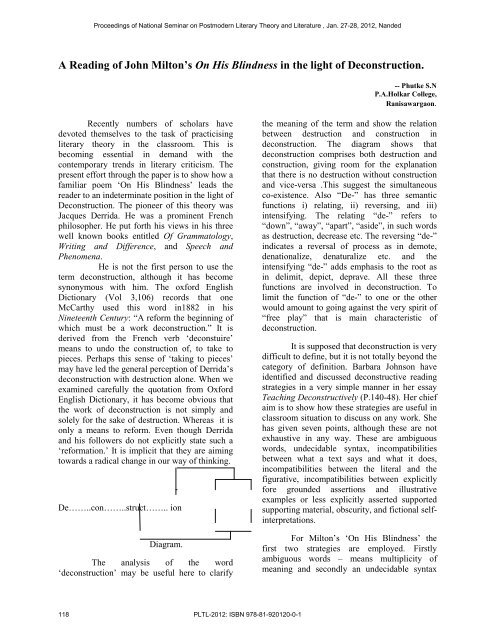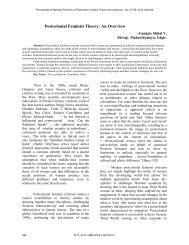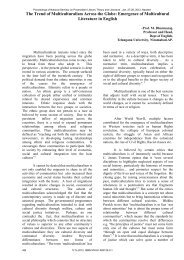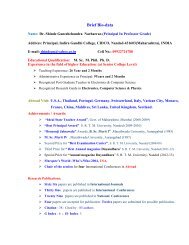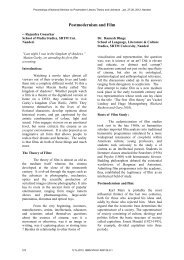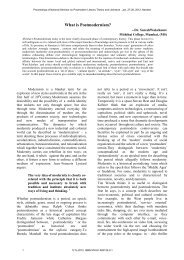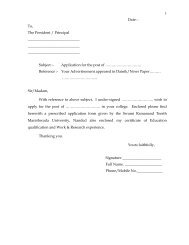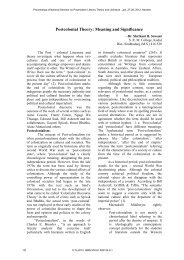Post-Structuralism: An Indian Preview - Igcollege.org
Post-Structuralism: An Indian Preview - Igcollege.org
Post-Structuralism: An Indian Preview - Igcollege.org
You also want an ePaper? Increase the reach of your titles
YUMPU automatically turns print PDFs into web optimized ePapers that Google loves.
Proceedings of National Seminar on <strong>Post</strong>modern Literary Theory and Literature , Jan. 27-28, 2012, Nanded<br />
A Reading of John Milton’s On His Blindness in the light of Deconstruction.<br />
-- Phutke S.N<br />
P.A.Holkar College,<br />
Ranisawargaon.<br />
Recently numbers of scholars have<br />
devoted themselves to the task of practicising<br />
literary theory in the classroom. This is<br />
becoming essential in demand with the<br />
contemporary trends in literary criticism. The<br />
present effort through the paper is to show how a<br />
familiar poem ‘On His Blindness’ leads the<br />
reader to an indeterminate position in the light of<br />
Deconstruction. The pioneer of this theory was<br />
Jacques Derrida. He was a prominent French<br />
philosopher. He put forth his views in his three<br />
well known books entitled Of Grammatology,<br />
Writing and Difference, and Speech and<br />
Phenomena.<br />
He is not the first person to use the<br />
term deconstruction, although it has become<br />
synonymous with him. The oxford English<br />
Dictionary (Vol 3,106) records that one<br />
McCarthy used this word in1882 in his<br />
Nineteenth Century: “A reform the beginning of<br />
which must be a work deconstruction.” It is<br />
derived from the French verb ‘deconstuire’<br />
means to undo the construction of, to take to<br />
pieces. Perhaps this sense of ‘taking to pieces’<br />
may have led the general perception of Derrida’s<br />
deconstruction with destruction alone. When we<br />
examined carefully the quotation from Oxford<br />
English Dictionary, it has become obvious that<br />
the work of deconstruction is not simply and<br />
solely for the sake of destruction. Whereas it is<br />
only a means to reform. Even though Derrida<br />
and his followers do not explicitly state such a<br />
‘reformation.’ It is implicit that they are aiming<br />
towards a radical change in our way of thinking.<br />
De……..con……..struct…….. ion<br />
Diagram.<br />
The analysis of the word<br />
‘deconstruction’ may be useful here to clarify<br />
the meaning of the term and show the relation<br />
between destruction and construction in<br />
deconstruction. The diagram shows that<br />
deconstruction comprises both destruction and<br />
construction, giving room for the explanation<br />
that there is no destruction without construction<br />
and vice-versa .This suggest the simultaneous<br />
co-existence. Also “De-” has three semantic<br />
functions i) relating, ii) reversing, and iii)<br />
intensifying. The relating “de-” refers to<br />
“down”, “away”, “apart”, “aside”, in such words<br />
as destruction, decrease etc. The reversing “de-”<br />
indicates a reversal of process as in demote,<br />
denationalize, denaturalize etc. and the<br />
intensifying “de-” adds emphasis to the root as<br />
in delimit, depict, deprave. All these three<br />
functions are involved in deconstruction. To<br />
limit the function of “de-” to one or the other<br />
would amount to going against the very spirit of<br />
“free play” that is main characteristic of<br />
deconstruction.<br />
It is supposed that deconstruction is very<br />
difficult to define, but it is not totally beyond the<br />
category of definition. Barbara Johnson have<br />
identified and discussed deconstructive reading<br />
strategies in a very simple manner in her essay<br />
Teaching Deconstructively (P.140-48). Her chief<br />
aim is to show how these strategies are useful in<br />
classroom situation to discuss on any work. She<br />
has given seven points, although these are not<br />
exhaustive in any way. These are ambiguous<br />
words, undecidable syntax, incompatibilities<br />
between what a text says and what it does,<br />
incompatibilities between the literal and the<br />
figurative, incompatibilities between explicitly<br />
fore grounded assertions and illustrative<br />
examples or less explicitly asserted supported<br />
supporting material, obscurity, and fictional selfinterpretations.<br />
For Milton’s ‘On His Blindness’ the<br />
first two strategies are employed. Firstly<br />
ambiguous words – means multiplicity of<br />
meaning and secondly an undecidable syntax<br />
118 PLTL-2012: ISBN 978-81-920120-0-1


